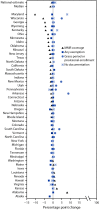Vaccination Coverage with Selected Vaccines and Exemption Rates Among Children in Kindergarten - United States, 2020-21 School Year
- PMID: 35446828
- PMCID: PMC9042357
- DOI: 10.15585/mmwr.mm7116a1
Vaccination Coverage with Selected Vaccines and Exemption Rates Among Children in Kindergarten - United States, 2020-21 School Year
Abstract
State and local school vaccination requirements serve to protect students against vaccine-preventable diseases (1). This report summarizes data collected for the 2020-21 school year by state and local immunization programs* on vaccination coverage among children in kindergarten in 47 states and the District of Columbia (DC), exemptions for kindergartners in 48 states and DC, and provisional enrollment or grace period status for kindergartners in 28 states. Vaccination coverage† nationally was 93.9% for 2 doses of measles, mumps, and rubella vaccine (MMR); 93.6% for the state-required number of doses of diphtheria, tetanus, and acellular pertussis vaccine (DTaP); and 93.6% for the state-required doses of varicella vaccine. Compared with the 2019-20 school year, vaccination coverage decreased by approximately one percentage point for all vaccines. Although 2.2% of kindergartners had an exemption from at least one vaccine,§ an additional 3.9% who did not have a vaccine exemption were not up to date for MMR. The COVID-19 pandemic affected schools' vaccination requirement and provisional enrollment policies, documentation, and assessment activities. As schools continue to return to in-person learning, enforcement of vaccination policies and follow-up with undervaccinated students are important to improve vaccination coverage.
Conflict of interest statement
All authors have completed and submitted the International Committee of Medical Journal Editors form for disclosure of potential conflicts of interest. No potential conflicts of interest were disclosed.
Figures


References
-
- CDC. SchoolVaxView. Atlanta, GA: US Department of Health and Human Services, CDC; 2019. https://www.cdc.gov/vaccines/imz-managers/coverage/schoolvaxview/data-re...
-
- US Department of Health and Human Services. Healthy people 2030: maintain the vaccination coverage level of 2 doses of the MMR vaccine for children in kindergarten—IID-04. Washington, DC: US Department of Health and Human Services; 2020. https://health.gov/healthypeople/objectives-and-data/browse-objectives/v...
MeSH terms
Substances
LinkOut - more resources
Full Text Sources
Medical
Research Materials

